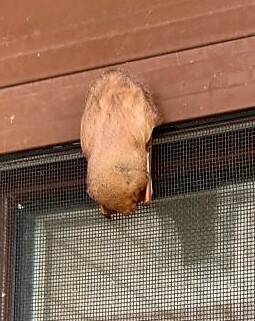
2021-11-10
MTRI biologist hopeful bat numbers will continue to rise
by KEVIN MCBAINLocal Journalism Initiative Reporter
There are increasing signs of a revival of Nova Scotia's decimated bat population with researchers seeing evidence of more and more of the mammals.
But the numbers in southwest Nova Scotia aren't out of the woods yet, and researchers are working hard to determine the current state of bat populations.
Biologist Lori Phinney and the Mersey Tobeatic Research Institute (MTRI) in Kempt are instrumental in the hunt.
"We're looking for bats in new locations, hoping to find sites where they spend the winters, looking in creepy dark spaces, and on concrete bridges and culverts," said Phinney. "A survey of this size hasn't really been done before and we are working on doing this through to 2023 as a project."
She said they are also hoping that people will report their bat sightings so they can continue to study the animal and find ways to help increase the population.
The most populous species in the province is the little brown bat. Others include the northern long-eared bat and the tri-coloured bat, all of which are listed as endangered in the province.
In an interview with LighthouseNOW in June, Phinney had reported more sightings of bats this year than in a long time, and while the trend was continuing she couldn't explain why.
Bat populations declined dramatically over the previous 10 years after a condition called White Nose Syndrome infiltrated bat populations in the province, killing about 90 per cent of the animals. White Nose Syndrome is reflected in white patches on the bats' bodies and causes them to wake up when they're in hibernation. They end up starving to death because there are no bugs to eat during the winter.
Phinney and her staff have been monitoring about 10 different sites this year and at each one they are discovering more bats all the time.
"One person we thought had five bats this summer in their barn in Queens County; we ended up finding about 60 which was a huge surprise," she said. "Another spot we thought had about 25, ended up having 50. It's quite exciting."
Phinney said that researchers in P.E.I. are also discovering increases in their bat population.
"We can't answer why. That's the frustrating part of this. Maybe bats are coming from different locations? I don't know, but we just need to keep looking and that's really the best thing we can do right now," she said.
Another project they have been working on is bat boxes and the best places to use them. She said the boxes are helpful in providing homes for bats, and it's been observed that bats seem to prefer the boxes when they are placed on buildings rather than in trees or on poles.
Phinney encourages property owners to be a part of the batbox community, noting the creatures are a beneficial mammal to have around. Not only do they have an incredible appetite for insects (more than 1,000 per hour), they are good pollinators as well.
Phinney is encouraging anyone who sees a bat on their property to call MTRI. Sightings can also be reported by calling 1-833-434-2287 or going online at www.batconservation.ca






